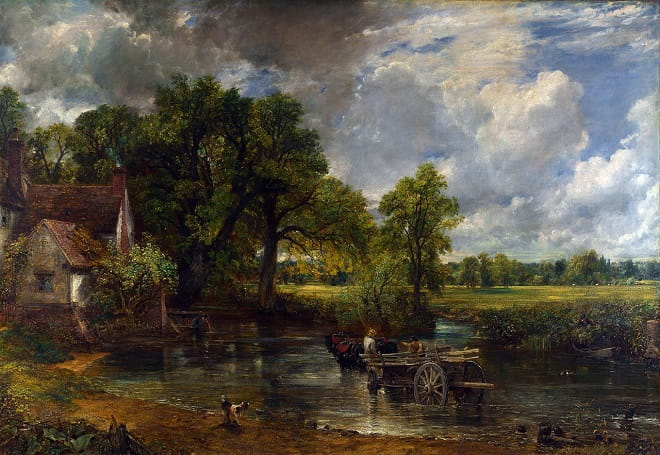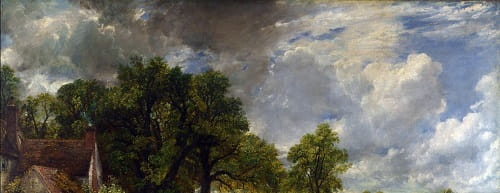The Hay Wain Analysis
‘The Hay Wain’ by John Constable is a celebrated masterpiece that has captured the hearts of art enthusiasts for generations. John Constable’s ‘The Hay Wain’ stands as an enduring testament to the beauty of the English countryside and the artistic genius of its creator. In The Hay Wain Analysis, we will delve into the rich history and intricate details of this iconic painting.
Join us on a journey to uncover the hidden meanings, artistic techniques, and enduring significance of ‘The Hay Wain.’
The Hay Wain Analysis: Discovering John Constable’s Masterpiece
Historical Context
Before we embark on our analysis, it’s essential to understand the historical backdrop against which ‘The Hay Wain’ was created. This knowledge will help us appreciate the painting’s significance within its time.

The Hay Wain, 1821 by John Constable – The National Gallery – The Story of The Hay Wain
Recommended For You – Top 5 Most Famous Representatives of the Romanticism Art
In the early 19th century, England was undergoing significant transformations due to the Industrial Revolution.
Constable’s work emerged during this period of change when rural landscapes were rapidly disappearing to make way for industrialization. ‘The Hay Wain,’ painted in 1821, serves as a poignant reminder of the vanishing pastoral world.
Artistic Techniques
John Constable was a master of capturing the beauty of the English countryside, and ‘The Hay Wain’ is a prime example of his skill. This section will explore the artistic techniques he employed to bring this scene to life.
1- Luminous Skies
Constable’s attention to detail is evident in the depiction of the ever-changing English skies.

Luminous skies detail of The Hay Wain – The Hay Wain Analysis.
Constable used vibrant, contrasting colors to recreate the play of light and shadow on the landscape, making the sky a central element of the composition.
2- Naturalism
John Constable was known for his commitment to portraying nature authentically. He spent considerable time sketching and studying the landscapes he painted, resulting in a high level of realism in his work.
‘The Hay Wain’ reflects this dedication to capturing the essence of rural life.
3- Symbolism and Interpretations
‘The Hay Wain’ is not merely a beautiful landscape; it also carries layers of symbolism and meaning. This section will explore some of the interpretations that art historians have proposed over the years.
4- The Tranquil Countryside
The painting can be seen as a nostalgic tribute to a simpler, more idyllic way of life. It serves as a reminder of the rural beauty that was rapidly disappearing due to industrialization.
Composition and Elements
1- Foreground
The foreground of ‘The Hay Wain’ prominently features a wooden cart filled with hay, pulled by a team of horses. The cart is driven by a man and accompanied by a dog. This central element anchors the composition and serves as a focal point.

Central elements of The Hay Wain – The Hay Wain Analysis.
2- Background
The background showcases a picturesque rural landscape with a cottage on the left.

The background showcases a picturesque rural landscape – The Hay Wain Analysis.
A tranquil river, the River Stour, flows through the scene, reflecting the surrounding trees and sky.
3- Color Palette
Constable’s color palette in ‘The Hay Wain’ is characterized by a harmonious blend of earthy tones and vibrant, natural hues. He uses various shades of green for the foliage, contrasting with the blue of the sky and the earthy browns of the cart and cottage.
The sky itself is filled with dramatic clouds rendered in shades of white and gray.
4- The Play of Light
One of Constable’s signature techniques is the portrayal of light and its effects on the landscape.
In ‘The Hay Wain,’ the artist captures the ever-changing English sky with remarkable precision. He utilizes the dappling effect of sunlight breaking through the clouds to create a sense of movement and atmosphere.

The dappling effect of sunlight in The Hay Wain – The story of The Hay Wain.
This technique adds depth and realism to the painting.
5- Attention to Detail
Constable’s meticulous attention to detail is evident in every aspect of the painting. From the intricate rendering of the foliage and the thatched roof of the cottage to the subtle reflections in the river, every element is carefully observed and skillfully depicted.
6- Narrative and Daily Life
‘The Hay Wain’ offers a glimpse into the daily life of rural England in the early 19th century. It portrays the simplicity of rural existence, where people work in harmony with nature.
The presence of the cart and the man driving it suggests agricultural activities, highlighting the importance of farming in this era.
Recommended For You – 10 Places From Famous Paintings That You Can Visit in Real Life
7- Constable’s Motivation
John Constable was deeply passionate about preserving the beauty of the English countryside.
‘The Hay Wain’ can be seen as a manifestation of this passion. It is a celebration of the rural landscape and a commentary on the encroachment of industrialization and urbanization on the natural world.
8- Influence on Art
‘The Hay Wain’ is often regarded as a precursor to the Impressionist movement, which would emerge later in the 19th century.
Constable’s emphasis on capturing the effects of light and his commitment to plein air (outdoor) painting laid the foundation for the techniques embraced by Impressionist painters like Claude Monet and Pierre Auguste Renoir.
9- Controversy and Recognition
Although ‘The Hay Wain’ is now considered one of the greatest landscape paintings in Western art history, it initially faced criticism from traditional art academies. However, it eventually gained recognition and acclaim, becoming an iconic representation of English landscape painting.
Symbolism in The Hay Wain
1- Agricultural Tradition
The central focus of the painting, the hay wain (a type of cart used for transporting hay), symbolizes the enduring agricultural traditions of rural England.

The hay wain details in the painting.
It represents the hard work and sustenance derived from the land. In the face of industrialization and urbanization, Constable’s choice to depict this humble, rustic cart emphasizes the importance of preserving the agrarian way of life.
2- The River Stour
Timelessness of Nature
The River Stour, flowing serenely through the landscape, symbolizes the timeless and unchanging aspects of nature. It remains unaffected by the rapid changes brought about by the Industrial Revolution.
Constable’s meticulous attention to the reflection of trees and the sky on the river’s surface highlights its role as a symbol of continuity and tranquility.
3- The Cottage
Rural Simplicity
The cottage on the left side of the painting represents rural simplicity and domestic life. It’s a visual reminder of the modest homes that dotted the English countryside during Constable’s time.

The cottage details in The Hay Wain – The Hay Wain Analysis.
The presence of the cottage reinforces the idea that the beauty of rural life lies in its unpretentious and harmonious coexistence with nature.
4- The Surrounding Landscape
Balance Between Man and Nature
The carefully rendered landscape, lush with trees and foliage, reflects the delicate balance between human activity and the natural world.
The trees provide shade, sustenance, and shelter for wildlife, showcasing the symbiotic relationship between man and nature.
5- The Changing Sky
Symbol of Transience
The dynamic sky, with its ever-shifting cloud formations, symbolizes the transient nature of existence.

The dynamic sky in the Hay Wain – The Hay Wain Analysis.
Constable’s ability to capture the play of light and shadow across the landscape through the changing sky speaks to the impermanence of life and the eternal cycle of nature.
6- The Dog
Loyalty and Faithfulness
The presence of the dog, loyal and faithful to its human companions, can be seen as a symbol of the enduring connection between people and the land they cultivate. It embodies the bond between humans and their environment, emphasizing the idea that this relationship is essential to a harmonious way of life.
Recommended For You – Allegories and Symbols in Paintings
Eternal Echoes: The Resonance of ‘The Hay Wain’
As we conclude our exploration of ‘The Hay Wain’ by John Constable, we are left not only with a profound appreciation for this masterpiece but also with a deep understanding of its enduring significance in the world of art.
Constable’s ability to capture the essence of rural life and the changing English landscape is nothing short of extraordinary. Through his meticulous attention to detail, his dynamic portrayal of light, and his deep connection to nature, he created a painting that continues to resonate with viewers of all generations.
But ‘The Hay Wain’ is more than a static image frozen in time. It is a dynamic work of art that has transcended its era. Its influence reverberates through the annals of art history, touching subsequent movements and artists.
The Impressionists, inspired by Constable’s dedication to capturing the effects of light and his commitment to plein-air painting, embraced similar techniques that would shape the course of art in the 19th and 20th centuries.
Beyond its artistic influence, ‘The Hay Wain’ holds a mirror to the changing world around us. It reminds us of the fragile balance between tradition and progress, between the unchanging beauty of nature and the relentless march of industrialization.
In our modern age, where the environment faces unprecedented challenges, Constable’s message about the importance of preserving our connection to the land resonates more strongly than ever.
‘The Hay Wain’ is not merely a painting but a timeless testament to the enduring power of art to provoke thought, evoke emotion, and inspire change. It invites us to reflect on our relationship with the natural world and our responsibility as stewards of the environment.
As we part ways with this masterpiece, let us carry with us the lessons it imparts: to cherish the beauty of our surroundings, to embrace the harmony between humanity and nature, and to recognize that art, in all its forms, has the capacity to shape our perception of the world and guide our actions toward a more harmonious future.
John Constable’s ‘The Hay Wain’ will forever remain a beacon of inspiration, reminding us of the timeless beauty that surrounds us and the enduring power of artistic expression.
References:
- https://en.wikipedia.org/wiki/The_Hay_Wain








